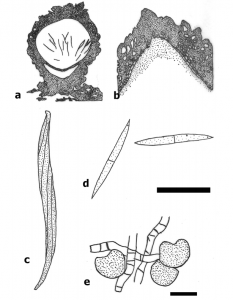Lasiobertia africana Sivan., Trans. Br. mycol. Soc. 70(3): 383 (1978)
Index Fungorum number: IF 316354, Facesoffungi number: FoF 01358
Saprobic on palms. Sexual morph: Ascomata erumpent and superficial, partially embedded in the thin subiculum, coarsely turberculate, dark brown or black, uniperitheciate, non-ostiolate, single or aggregated to form groups, globose, in cross-section 340–510 × 250–370 µm (x̄ = 378 × 325 μm, n = 10), with sterile stalk 100–140 × 180–230 µm (x̄ = 137 × 205 μm, n = 10), basal region of the stalk slightly immersed in the host tissue. Peridium >50 µm wide, comprising several layers, outwardly comprising thick-walled, coriaceous, brown, pseudoparenchymatic cells, middle cell layers dark brown, thick-walled, globose, inwardly comprising less thickened, pale brown cells. Hamathecium comprising numerous, hyaline, filiform parapahyses. Asci 140–175 × 9–11 µm (x̄ = 153 × 10 μm, n = 20), 8-spored, unitunicate, cylindrical, pedicellate, with a distinct, J+, apical apparatus. Ascospores 55–74 × 4.5–6 µm (x̄ = 62 × 5 μm, n = 20), overlapping uniseriate, hyaline, 2-celled, elongate fusoid, septate in the middle, with slightly curved, pointed ends, smooth-walled. Asexual morph: Hyphomycetous, melanographium-like. Conidiophores simple, extensively branched, brown, septate, erect, smooth, variable in length, up to 400 µm long, 3.5 µm wide at the base, macronematous. Conidiogenous cells polyblastic, terminal, integrated, short, cylindrical, sympodial, and light brown, with short, cylindrical denticles. Conidia 11–20 × 5.5–10 µm (x̄ = 17 × 7 μm, n = 20), solitary, dry, dark brown, simple, ovoid to reniform, 1-celled, with a hyaline longitudinal slit (re-described from Sivanesan 1978).

